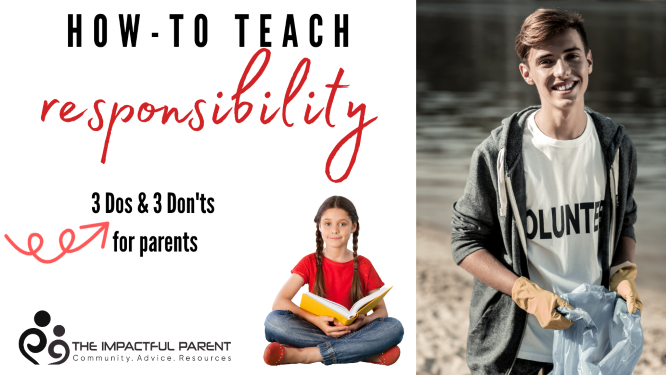Teaching Responsibility: 3 Dos and 3 Don’ts for teaching responsibility to your child
How do we teach children responsibility at different ages and different stages of development? First, what does it mean to teach responsibility? What would be the end goal for you? For me, teaching responsibility is teaching my child (#1) how to be dependable. Can my child be counted on? Do they keep their commitments? Do they keep their word? (#2) Being responsible also means to me that my child is accountable for their behavior. Can they take ownership of their choices and with that- even own the consequences of their actions and lastly, (#3) Being responsible also means that my child is an active contributor to their world. For me, being responsible is an active role, not a passive attitude. Responsibility requires action and is not something that just happens to people. Responsibility is something that people choose to be or do actively.
So how do we teach responsibility then? We cannot do this overnight. It takes time- even years. Part of teaching your child HOW to be responsible is also letting them TAKE responsibility for their choices. Not wanting your child to fail and sheltering them from consequences and pain or even doing too much for your child- does not teach your child to take responsibility for themselves. On the other hand, there are times when children need guidance and support so that they can learn how to be responsible.
So how do we keep this balance and grow children who are responsible? Here are 3 TO-DO and 3 DO-NOT-DO items:

Teaching Responsibility Tip #2: Set limits and boundaries on what YOU will do for your child. This is true for all ages and all levels of development. If your child has the cognitive ability to do their laundry- then let them. If they can only sort out the colors from the whites- then let them. At some point, you have to say- I am not doing this for you anymore. You are old enough now to do for yourself. Setting limits and boundaries teach your child how to behave, teaches values, and shows them not only new expectations but you are inadvertently telling your child that you trust them. You are allowing them to grow up and instead of stifling their growth by doing everything for them. Along these same lines of creating boundaries, parents should not meet every need for their child at the moment they need it. This is just setting up your child for disappointment when the real world does not cater to them. By not meeting their needs immediately and not giving them everything they want, you provide an opportunity for your children to tolerate some frustration, delay gratification, become less impulsive and less self-centered.
Teaching Responsibility Tip #3: Let them face the consequences. Set standards of behavior that you expect your children to meet. You establish consequences for breaking the rules, and you follow through on those consequences. I follow through with consequences with my kids in a matter-of-fact kind of manner. We talk about the choices they made. We discuss how things could have been better. We plan for next time this happens, and then they face the current consequences for their actions. Period. No more discussion. No more obsessing about the past and what-ifs. Just take the consequence and move forward. Let your child whine to their friends if they want but make them sit with their consequences. Bring love and learning to the frontlines, and soon you will be fostering their development of taking responsibility.

Teaching Responsibility DO NOT Tip #2: Don’t too much for them. Do not be a hover parent, the helicopter parent, or the lawnmower parent. A hover or helicopter parent is always right over the child, ready to rescue them whenever they anticipate trouble. A lawnmower parent mows down all the obstacles their child can face. This kind of parenting is a disservice to your child. Doing things for your child that they can do themselves results in them not learning how to care for themselves.
Teaching Responsibility DO NOT tip #3: Don’t do things yourself just because it is easier. I know this is difficult. Remember when your child was a toddler, and they just wanted to tie their shoes, but you had to get out the door in 5 minutes, so you just tied the shoes yourself or bought Velcro straps? Yeah- me too. I did it. And the consequence is that my seven-year-old still does not tie her shoes well. I did a disservice to my child by buying Velcro because I did not want to be inconvenienced. Now that your child is older, the stakes are higher. They need to learn responsibility, and you cannot shy away from it because it may take you an extra hour to teach it.
For more Impactful Parent content visit https://theimpactfulparent.com and check out The Impactful Parent Youtube channel!
Follow The Impactful Parent on social media too! Facebook, Instagram, Pinterest, and LinkedIn

